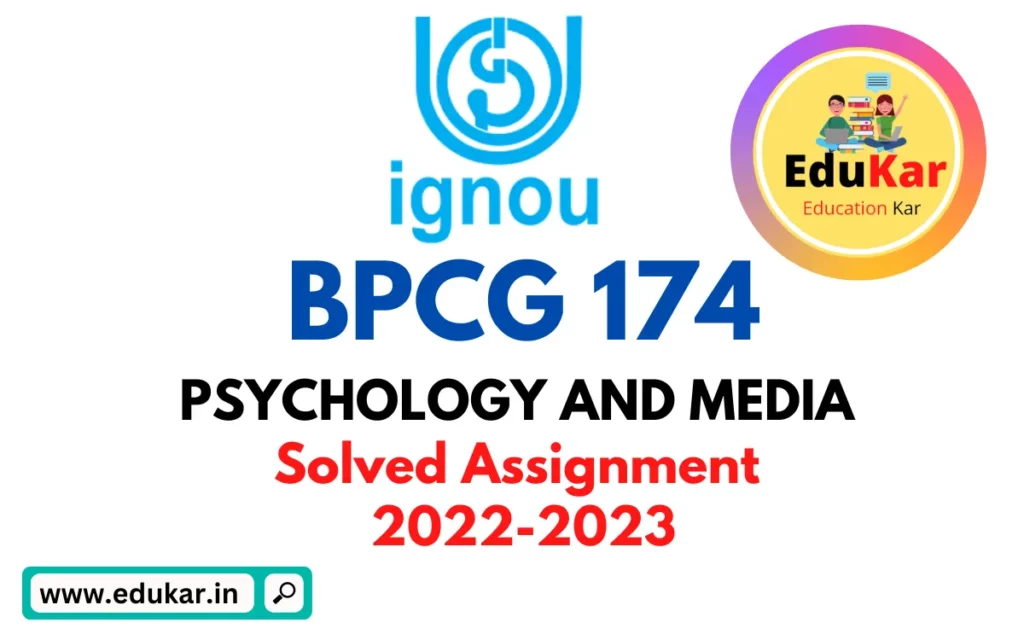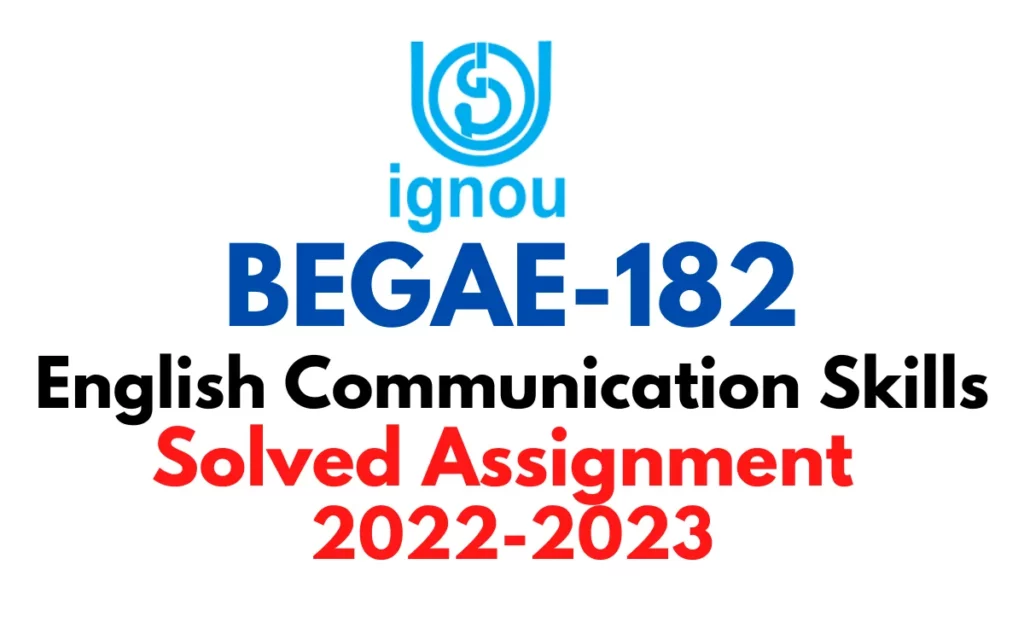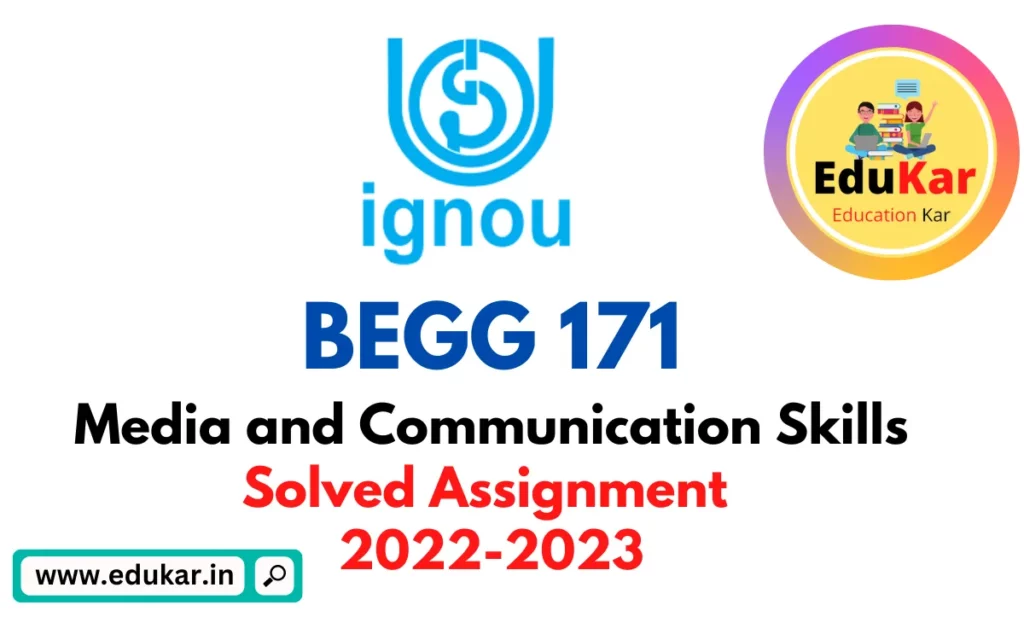Contents
- 1 Assignment One
- 2 Answer the following questions in about 500 words each.
- 3 1. Explain the relationship between psychology and media. Discuss the role of media psychologist.
- 4 2. Elucidate the characteristics of a parasocial relationship. Discuss the factors affecting parasocial relationship.
- 5 Assignment Two
- 6 Answer the following questions in about 250 words each.
- 7 3. Define media. Explain the significance and functions of media.
- 8 4. Explain the theory of Social Constructionism and differentiate it from Symbolic Interactionism.
- 9 5. Describe the role of media in development of education.
- 10 Assignment Three
- 11 Answer the following questions in about 100 words each.
- 12 6. News framing
- 13 7. Classification of cybercrime
- 14 8. Media and well-being
- 15 9. Health education and mass media
- 16 10. Gaming addiction
Welcome to Edukar. Find all the answers to the questions in BPCG 174 course with our solved assignment. Carefully crafted by experts, in accordance with the latest syllabus and guidelines set by IGNOU. Boost your understanding and secure good grades with ease.

| Title | IGNOU-BPCG 174 Solved Assignment 2022-2023 (PSYCHOLOGY AND MEDIA) |
| University | IGNOU |
| Degree | Bachelor Degree Programme |
| Course Code | BPCG 174 |
| Course Name | PSYCHOLOGY AND MEDIA |
| Programme Name | Bachelor of Arts (General) |
| Programme Code | BAG |
| Total Marks | 100 |
| Year | 2022-2023 |
| Language | English |
| Assignment Code | Asst /TMA / July 2022- January 2023 |
| Last Date for Submission of Assignment: | For June Examination: 31st March For December Examination: 30th September |

Assignment One
Answer the following questions in about 500 words each.
1. Explain the relationship between psychology and media. Discuss the role of media psychologist.
Ans: Psychology and media are two interrelated fields that are deeply connected. Media refers to the various channels and platforms used to disseminate information to a large audience, such as television, film, newspapers, and the internet. Psychology, on the other hand, is the study of human behavior and mental processes. The relationship between psychology and media is complex and dynamic, and it is essential to understand the ways in which they interact and influence one another.
The media has a significant impact on human behavior and thoughts, and it is essential to understand how this works. For example, media can influence our perceptions of reality, shape our attitudes, and create biases. The way media presents information can also affect our emotions and influence our decision-making processes. For example, media can present events in such a way as to elicit fear, anger, or sadness, which can lead to changes in behavior and attitudes.
The relationship between psychology and media also extends to the role of media psychologists. Media psychologists study the effects of media on human behavior and cognition and the ways in which media can be used to influence behavior and attitudes. Media psychologists also work to understand how media can be used to enhance the quality of life and mental health of individuals and communities.
One important role of media psychologists is to help media creators and marketers understand the psychological impact of their messages and how to create content that is effective and engaging. For example, media psychologists can help determine the best way to present information to maximize its impact on the target audience. They can also help media creators and marketers understand the emotional reactions that their messages may evoke and how to create content that is more likely to engage people and elicit positive emotional responses.
Another important role of media psychologists is to help individuals and communities understand the impact of media on their lives. Media psychologists can provide information and support to help individuals and communities understand the ways in which media can affect their mental health, relationships, and overall well-being. They can also provide recommendations on how to limit exposure to media that may be harmful and promote media use that is beneficial.
Ans: A parasocial relationship is a type of one-sided relationship that occurs between an individual and a media figure, such as a celebrity or a television character. This relationship is characterized by the feeling of intimacy, familiarity, and emotional connection that a person may have with a media figure, despite the fact that the relationship is not reciprocal. Parasocial relationships are a common phenomenon and have been the subject of much research in the fields of psychology and media studies.
The following are some of the key characteristics of parasocial relationships:
- One-sided: Parasocial relationships are one-sided, meaning that they involve only one person who is engaging with a media figure. This person may feel a deep connection to the media figure, but the media figure is not aware of or involved in the relationship.
- Feelings of intimacy and familiarity: People who form parasocial relationships often feel as though they know the media figure intimately, and they may feel a sense of familiarity with them. This feeling of intimacy can lead to feelings of closeness and emotional attachment to the media figure.
- Emotional involvement: Parasocial relationships are often marked by a high level of emotional involvement. People who form these relationships may become emotionally invested in the lives of the media figures they follow, and they may feel intense emotions when these figures experience success or failure.
- Imagined interactions: People who form parasocial relationships often imagine interactions with the media figure that are not actually taking place. This may involve imagining conversations with the media figure, picturing themselves as friends, or imagining the media figure as a romantic partner.
- Limited information: People who form parasocial relationships usually have limited information about the media figure. This can lead to a distorted view of the media figure, as the person may fill in the gaps in their knowledge with their own imaginations.
There are several factors that can affect the development and maintenance of parasocial relationships. Some of these factors include:
- Media exposure: The amount of exposure a person has to a media figure is a key factor in the development of a parasocial relationship. People who are exposed to a media figure on a regular basis are more likely to form a parasocial relationship with that figure.
- Demographic characteristics: Demographic characteristics, such as age, gender, and socio-economic status, can also affect the development of parasocial relationships. For example, research has shown that young people are more likely to form parasocial relationships than older people.
- Personality traits: Personality traits, such as social isolation, shyness, and introversion, can also influence the formation of parasocial relationships. People who are socially isolated or shy may be more likely to form parasocial relationships as a way to cope with their feelings of loneliness and disconnection from others.
- Media content: The content of the media itself can also affect the development of parasocial relationships. For example, media that is engaging and emotionally compelling is more likely to foster parasocial relationships than media that is not as engaging.
Assignment Two
Answer the following questions in about 250 words each.
3. Define media. Explain the significance and functions of media.
Ans: Media refers to the various means of communication that are used to convey information and messages to large audiences. It encompasses a wide range of platforms and technologies, including traditional forms such as print, television, and radio, as well as digital forms such as the internet, social media, and mobile devices.
The significance of media lies in its ability to reach and influence large groups of people. It plays a crucial role in shaping public opinion and attitudes by providing information, entertainment, and educational content. Media also serves as a powerful tool for social and political change, allowing individuals and organizations to share their views and perspectives with a wider audience.
One of the key functions of media is to inform the public by providing accurate and up-to-date information on current events and important issues. This includes reporting on news and current events, as well as providing in-depth analysis and commentary on complex topics. Media also serves an educational function by providing access to a wealth of information and resources that can be used for learning and personal development.
Another function of media is to entertain and provide entertainment for its audiences. This includes movies, TV shows, music, and video games, as well as interactive forms of entertainment like social media and online gaming.
In addition to these functions, media can also serve as a means of communication and connection between individuals, communities, and cultures. Social media platforms and other digital technologies have made it easier than ever for people to connect and share information, regardless of geographical location.
4. Explain the theory of Social Constructionism and differentiate it from Symbolic Interactionism.
Ans: Social Constructionism is a theoretical perspective that focuses on the ways in which meaning is constructed and reconstructed through social interaction and communication. According to this perspective, social realities and identities are not determined by some objective or essential characteristics of individuals, but rather they are shaped and constructed through ongoing social processes.
Social constructionism suggests that knowledge, meaning, and reality are not fixed but rather are constantly evolving and being reinterpreted through human interaction. This means that social constructions are not simply “out there,” but are actively produced and maintained through human activity. For example, gender, race, and sexuality are not biologically determined but are social constructions that are created and re-created through social interactions.
Different from Social Constructionism, Symbolic Interactionism is another theoretical perspective that focuses on how individuals create and interpret meaning in their interactions with others. It views the individual as an active creator of meaning, and suggests that social reality is constructed through the interpretation of symbols.
Symbolic Interactionism emphasizes that individuals use symbols to interact and make sense of the world around them, and that these symbols are shaped by social context and the relationships they have with others. For example, the meaning of a particular gesture or word can vary depending on the cultural context and the relationships between the individuals involved in the interaction.
While both Social Constructionism and Symbolic Interactionism share a focus on the social construction of meaning, they differ in their emphasis. Social Constructionism emphasizes the role of society and culture in shaping meaning, while Symbolic Interactionism focuses more on the individual’s role in creating and interpreting meaning.
5. Describe the role of media in development of education.
Ans: The media plays a significant role in the development of education by providing access to information, resources, and educational opportunities that were previously unavailable. The widespread availability of digital technologies and the internet has revolutionized the way in which education is delivered, making it more accessible and convenient for people around the world.
One of the key ways in which the media has impacted education is through the development of online learning and educational technologies. These technologies have made it possible for people to access high-quality educational content and resources from anywhere in the world, providing access to education that was previously unavailable or difficult to obtain.
The media also plays a key role in disseminating information about educational opportunities, helping people to find programs and courses that are best suited to their needs and interests. This has been especially important in developing countries, where access to information about educational opportunities is often limited.
In addition to providing access to educational content and resources, the media also serves as a tool for promoting and supporting education. Through media campaigns and public service announcements, organizations and government agencies can raise awareness about the importance of education and encourage people to seek out educational opportunities.
The media has also played a critical role in promoting diversity and inclusivity in education by providing a platform for marginalized and underrepresented communities to share their perspectives and experiences. This has helped to broaden the conversation about education and to make it more inclusive, reflecting the diverse experiences and needs of individuals and communities.
Assignment Three
Answer the following questions in about 100 words each.
6. News framing
Ans: News framing refers to the way news stories are presented and framed by journalists, media organizations, and other sources of news information. News framing can involve selecting certain aspects of a story to emphasize, downplaying others, and shaping public perception and understanding of events and issues. News framing can have a significant impact on how people understand and interpret events, as well as shaping public opinion and decision-making. It is therefore important for journalists and news organizations to be aware of the potential for news framing to influence public perception and to strive to provide objective, unbiased, and accurate news coverage. The study of news framing is a growing area of research within the fields of media studies and psychology.
7. Classification of cybercrime
Ans: Cybercrime is a type of crime that is committed using the internet, digital devices, and other forms of technology. Cybercrime can take many forms, including hacking, identity theft, fraud, and the distribution of illegal or harmful content. Cybercrime can have serious consequences for individuals, businesses, and society as a whole, and is therefore a growing area of concern for law enforcement agencies and policymakers. The classification of cybercrime can vary, but one common way of categorizing it is into the following categories: crimes against individuals, such as identity theft and cyberstalking; crimes against businesses, such as cyber-espionage and intellectual property theft; and crimes against society, such as the distribution of illegal or harmful content and the use of the internet for illegal activities. Understanding the different types of cybercrime and their impacts is an important step in addressing and preventing these crimes.
8. Media and well-being
Ans: Media, including television, social media, and other digital platforms, can have both positive and negative impacts on well-being. On the one hand, media can provide entertainment and a source of social connection for people. On the other hand, excessive media use can contribute to feelings of anxiety, depression, and decreased self-esteem, as well as lead to physical health problems, such as disrupted sleep patterns. It is therefore important to use media in a balanced and responsible way, and to be mindful of its potential impact on well-being. Research in the fields of psychology and media studies has found that there are several factors that can influence the impact of media on well-being, including the content of the media, the context in which it is consumed, and the individual’s own personal characteristics and life circumstances. By being mindful of these factors, individuals can make more informed decisions about their media use and promote their overall well-being.
9. Health education and mass media
Ans: Health education and mass media have a symbiotic relationship in promoting public health and wellness. Mass media, including television, radio, print media, and social media, play an important role in delivering health information to the general public. Health education, on the other hand, helps to promote critical thinking and decision-making skills related to health and wellness. Mass media can be used to raise awareness about various health issues, provide information on disease prevention and management, and promote healthy behaviors. At the same time, health education can help individuals to critically evaluate and make informed decisions based on the information they receive from mass media. When health education and mass media work together, they can help to create a more informed and health-conscious society, and improve health outcomes for individuals and communities.
10. Gaming addiction
Ans: Gaming addiction is a type of behavioral addiction characterized by excessive and compulsive involvement in video games, to the point where it interferes with a person’s daily life and responsibilities. People who suffer from gaming addiction may experience symptoms such as neglecting personal hygiene, sleeping and eating patterns, and interpersonal relationships. The overuse of video games can lead to physical problems, such as eye strain and repetitive strain injury, as well as mental health issues, such as anxiety and depression. In extreme cases, gaming addiction can lead to financial problems and job loss. It is important to recognize the signs of gaming addiction and to seek help if needed. Treatment options may include therapy, support groups, and medication. By addressing the underlying psychological and emotional issues, individuals can regain control of their lives and reduce the negative impact of gaming addiction.
How to Download BPCG 174 Solved Assignment?
You can download it from the www.edukar.in, they have a big database for all the IGNOU solved assignments.
Is the BPCG 174 Solved Assignment Free?
Yes this is absolutely free to download the solved assignment from www.edukar.in
What is the last submission date for BPCG 174 Assignment?
For June Examination: 31st March, For December Examination: 30th September










![[Solved Assignment] BPCS 188-APPLICATIONS OF SOCIAL PSYCHOLOGY (IGNOU-BAG) 2022-2023 BPCS 188-APPLICATIONS OF SOCIAL PSYCHOLOGY IGNOU BAG Solved Assignment 2022-2023](https://edukar.in/wp-content/uploads/2023/01/BPCS-188-APPLICATIONS-OF-SOCIAL-PSYCHOLOGY-IGNOU-BAG-Solved-Assignment-2022-2023-1024x640.webp)





